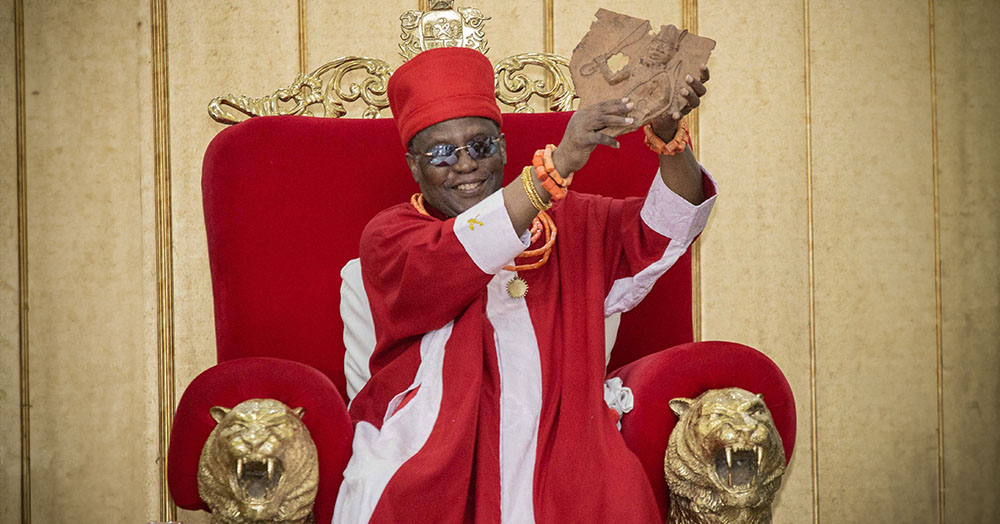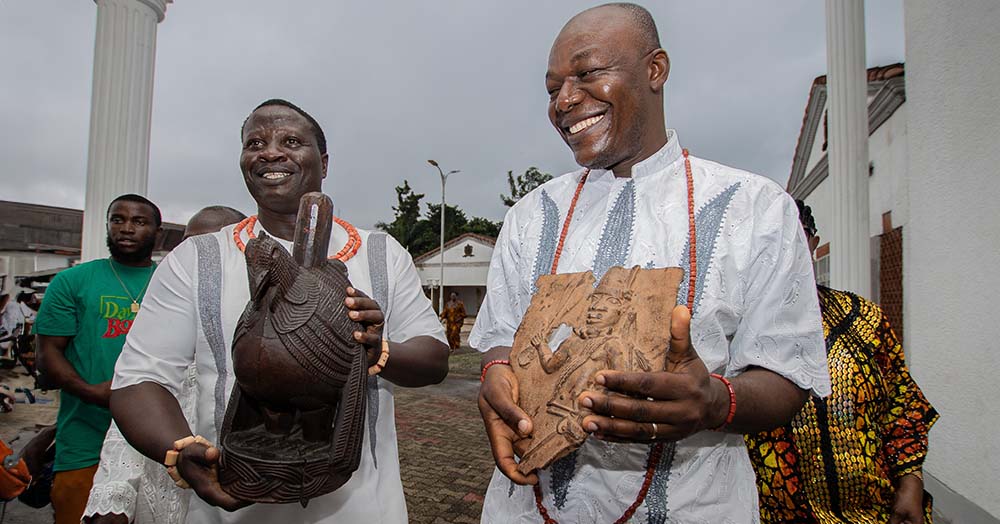UI Stanley Museum of Art Returns Sacred African Objects
 PHOTO: OMOREGIE OSAKPOLOR/COURTESY UI STANLEY MUSEUM OF ART
Oba Ewuare II holds the brass plaque presented to him by UI Stanley Museum of Art curator Cory Gundlach during the restitution ceremony earlier this summer at the Royal Palace of the Oba of Benin.
PHOTO: OMOREGIE OSAKPOLOR/COURTESY UI STANLEY MUSEUM OF ART
Oba Ewuare II holds the brass plaque presented to him by UI Stanley Museum of Art curator Cory Gundlach during the restitution ceremony earlier this summer at the Royal Palace of the Oba of Benin.
Lauren Lessing was in her first months as director of the University of Iowa Stanley Museum of Art in 2018 when a faculty member asked if there was any art looted during conflict, colonization, or war in its collection. The inquiry came immediately after the release of a highly publicized report commissioned by French President Emmanuel Macron to assess the history and present state of publicly owned African artworks in France.
Cory Gundlach (12MA, 19PhD), the museum’s curator of African art, told Lessing that he suspected several objects from the Kingdom of Benin might have been looted in the 19th century by British soldiers. If that were true, he said, “My training and my heart tell me these need to go back to the royal family.”
This past summer, the Stanley Museum of Art became the first in the U.S. to return objects from the Kingdom of Benin in present-day Nigeria directly to the Oba, the ruler of the Edo people. After years of meticulous research, the Stanley discovered that the histories of a wooden altarpiece it acquired in 1986 and a plaque acquired in 2001 trace back to the British siege of the Kingdom of Benin in 1897.
The issue of restitution was amplified by the 2020 publication of The Brutish Museums: The Benin Bronzes, Colonial Violence, and Cultural Restitution. Authored by British curator Dan Hicks, the book provided a stark account of Britain’s violent attack and massive pillaging of the Kingdom of Benin. The British Museum took possession of 900 objects, including brass plaques that serve as the kingdom’s historic record and which have become synonymous with colonial theft. Up to 10,000 objects were pocketed by British soldiers who were photographed in 1897 sitting atop piles of artworks.
In 2020, a modest grant allowed the Stanley to hire a student to do provenance research. Mason Koelm (21BA, 21BS, 24JD) used a global network of digital resources to follow the ownership of more than 300 objects. “I had an Indiana Jones globetrotting experience every day while sitting in my cubicle wearing a mask in the midst of a pandemic,” he says.
 PHOTO: OMOREGIE OSAKPOLOR/COURTESY UI STANLEY MUSEUM OF ART
Palace dignitaries carry the Benin bronzes during the restitution ceremony.
PHOTO: OMOREGIE OSAKPOLOR/COURTESY UI STANLEY MUSEUM OF ART
Palace dignitaries carry the Benin bronzes during the restitution ceremony.
Eventually, two Stanley objects were traced to the wills of soldiers who participated in the 1897 raid. It was a rare example of an unbroken chain of provenance—unequivocable proof that the pieces had been forcibly taken. They had to be returned. But to whom?
Many museums were choosing to repatriate objects to the Nigerian government, the location of the historic Kingdom of Benin. Gundlach didn’t think this was the right approach. Doing so would be akin to another country returning a Native American object to the U.S. government instead of the tribal government. He needed a point of connection to the royal family. He found it through Adepeju Layiwola, a professor at the University of Lagos and a granddaughter of the current Oba, whom he met at a conference.
“We were the only museum pursuing this route,” says Lessing.
In 2023, when the President of Nigeria affirmed the Oba’s right to returned objects, the Stanley was ready. This past July, Gundlach and Layiwola traveled to Nigeria and personally delivered the pieces to the Oba in a ceremony at his royal palace.
Having created a path for restitution, Lessing says the Stanley plans to organize workshops to help other museums do the same. Final research is being completed on two other Stanley objects that will also be returned. And a grant from the Mellon Foundation has allowed Layiwola to increase her provenance research of the Stanley’s collection.
After more than a century, these sacred objects have finally returned home. “The violence and loss associated with these objects can never be forgotten,” said Gundlach in his formal address to the Oba. “The Stanley Museum of Art is committed to acknowledging this tragic chapter in history and using it as a catalyst for positive change.”
